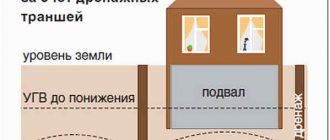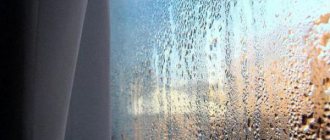2.1. Air Dryer.
2.2. Ventilation.
2.3. Hood.
2.4. Heated towel rail.
2.5. Cleaning ventilation.
3. Solving problems with excess moisture during construction and renovation.
How to dry a house or apartment? How to remove humidity in a room? Excess moisture in the air is a pressing problem. After reading the article of the professional construction portal Stroyka.ru, you can learn about ways to remove moisture from a room, identify and eliminate the causes of humidity in a country house, house, or apartment.
Before wondering how to dry an apartment from dampness, or how to dry a house, it is worth determining the causes of high humidity in the room. A damp room, a room with high air humidity is always a problem. The problem of the appearance of fungus, mold on the walls, in the corners, the problem of swelling of wallpaper, laminate or other floor covering, deformation of furniture and interior items. High humidity also affects health - it noticeably worsens with prolonged stay in such rooms. An increase in humidity in a room causes an unpleasant musty smell and stuffiness in the air. Things and clothes become damp and may also smell unpleasant.
If the apartment has humid air in at least one room, then neighboring rooms may also suffer from increased moisture. And before taking measures to dry the air in the room, you need to find out the reason or reasons for the formation of high humidity in the house.
Excess moisture causes condensation on windows
Humidity standards in a residential area
It is believed that the normal humidity of a living space is about 40-60%. In summer and winter it will change when the heating is turned on and off. A hygrometer will help measure such indicators. To take readings in an apartment, it is better to use an electronic hygrometer.
Both dry and too humid air are dangerous for the human body. And for fans of air conditioners there is a separate reason to worry. It literally pulls water out of the air, drying it out excessively. Even damp laundry or infrequent airing can increase humidity.
No. 2. Towels and bottles on the radiator
A simple folk method is to hang a damp towel on the radiator . The advice is effective, but you will have to change or re-wet the towel very often, because resourceful housewives once came up with the idea of dipping the tip of a towel/gauze/cotton fabric into a plastic bottle suspended from the radiator, in which they made a hole in the wall and poured water into it.
Another option is to simply hang a few water bottles behind the radiator . To ensure that the evaporation area is sufficient, it is better to make a hole in the wall rather than just unscrew the lid. The bottle can be decorated.
A more modern way is special humidifiers for the battery . The principle of operation is the same as that of simple bottles, but it will all look prettier. Such humidifiers are also filled with water, which then evaporates naturally; only the devices themselves are made of ceramics, steel, plastic and other materials. They can have almost any shape and color, so they will fit well into the interior, becoming its unusual decoration. Guests who are not in the know may not understand at all that this is a humidifier and not decor.
Tip – you will most likely need several bottles or humidifiers to speed up the hydration process.
Why is it worth drying out too humid air?
High humidity leads to the appearance of fungus in the house. Its spores are carried through the air, penetrating the lungs of the inhabitants and guests of the house. This causes rhinitis and asthma. If you live permanently in such unfavorable conditions, you are likely to suffer from chronic rhinitis, migraines, and disturbances in the functioning of the cardiovascular system. But there is no need to panic, in most cases you can successfully reduce the humidity.
Causes of dampness in the room
There are many sources of moisture in the house:
- shower, bath;
- washing clothes, drying them in the apartment;
- aquariums;
- plants;
- groundwater;
- external environment;
- people's breathing.
Among the main reasons for increased humidity are the following:
- Natural ventilation is disrupted. This is the most common reason. It is often associated with replacing windows with plastic ones. Unscrupulous manufacturers may save money and not provide the product with a special ventilation system. Such windows are too sealed and simply do not allow moisture to escape from the home. Condensation appears and mold forms.
- The foundation and walls are poorly insulated from moisture. This is due to a violation of the construction technology of a residential building. With such errors, the foundation transfers moisture to all the walls, and they evaporate it into the room. Such defects are practically irreparable.
- Oddly enough, the third most common cause is salt. It can be added to the foundation in winter to make it strong even in frost. If there is salt in concrete walls, they will be constantly wet. In this case, you need to be patient. After a few years, the walls will finally dry out.
- Frequent rains. At the same time, dampness from the street moves into the house.
- Aquariums, home fountains, waterfalls. They are best placed in rooms with a dry climate.
- Drying clothes in the rooms and kitchen.
- The windows do not face south. A shady location increases humidity.
- Weak central heating in the apartment.
- Leaking roof.
Exhaust systems
The kitchen area must be equipped with an exhaust system. The main tasks of such a device are to capture and remove evaporation. The hood ensures exchange and freshness of air in the kitchen itself and throughout the home. Today you can see three types of hoods on sale. Flat hoods are equipped with special filtering systems that absorb air, purify it and return it to the room. On dome-type exhaust devices, elbow pipes are installed, through which the air is removed into the ventilation system and is no longer returned to the room. Hoods of the third type combine the features of flat and dome systems. Such devices are the most effective and practical.
Ways to reduce humidity in your home
You can reduce humidity using various means, but first it is important to identify the exact reason for its increase in your home.
- High air humidity may be temporary, for example during cooking. In this case, ventilation will help. You can use available means, for example, turn on the heater. The main thing is to ensure good circulation and oxygen access. The air flow in the room should be especially powerful if moisture begins to condense on the walls. This can be achieved using a regular draft.
- A damp room should be regularly heated with a heating device.
- Poor ceiling condition can also lead to increased dampness. It's not easy to dry it. You can try to plaster again. At the same time, the furniture is taken out so that moisture does not absorb into it.
- PVC windows can significantly limit the access of air into the home and cause dampness in it. When ordering frames, specify the presence of a special ventilation system.
- There are modern means for treating rooms that reduce humidity (for example, “Stop-moisture”). They contain absorber crystals, an absorbent. The moisture ends up in special containers.
So, you can improve humidity indicators yourself:
- Ensure sufficient sunlight penetration into the room. Open curtains regularly. There should be no bulky flowers on the windowsills.
- Ventilate more often (three times a day for half an hour). Ventilation is especially effective in summer and winter, when the air outside is as dry as possible. You can leave the kitchen window open at night.
- Ensure proper ventilation. Check whether the ventilation window is closed and whether the system itself is working.
- If it is very damp, you can turn on a household heater. It will quickly heat and dry the air.
- Drywall and wood are building materials that prevent high humidity. Use them when making repairs.
- Even walls can be covered with plasterboard. Waterproofing plaster will also help solve the problem.
- Insulate the walls outside. This will help, unless of course a flooded basement led to dampness.
- Install a hood in the kitchen. Turn it on every time you cook. Cover kitchen utensils with lids.
- Candles, a hairdryer, and even indoor plants (that don't require frequent watering) will help dry out the room's "atmosphere" a little.
- If dampness has settled in the closet, iron the clothes with a hot iron.
How to dry the wall of a house on your own?
Of course, completely different actions will be performed for internal and external walls. In particular, for drying walls inside the house, the order will be as follows:
- The first step is to remove all water-damaged elements from the wall - wallpaper, wall panels, tiles, etc. If the wall is very flooded, you will have to remove the plaster - both at the site of flooding and about 0.5 meters above it;
- Next, you should begin cleaning the walls and disinfecting them;
- Once all the moisture has dried, you can reapply the plaster and begin finishing.
Drying exterior walls will be a little more challenging:
- If your house has a layered wall structure, check if there is water in the subsequent layers? How? Simply drill a hole above the base of the wall. If water appears, you will have to make holes across the entire width of the wall at intervals of approximately 1 meter;
- Then, as with interior walls, the plaster should be scraped off;
- The next step is to clean and disinfect the walls;
- If your home's insulation has been severely flooded, we will have to replace it. Of course, this will be quite expensive, so if you don't have the budget to replace the insulation, you could try simply drying it out, then cleaning and disinfecting it.
Dehumidifier: operating principles
We described in detail how to dehumidify the air in an apartment without a dehumidifier, but in some cases you cannot do without this device. A dehumidifier is used if the humidity in the apartment is too high, and other methods of combating it have not helped.
- Its operation is based on the absorption of air through the evaporator. The temperature inside the device is lower than in the room. Moisture condenses on its walls and flows into the container. In this case, the dried stream flows back into the room.
- So, this device will help you quickly dry out too humid air in your apartment. The desiccant can be portable or stationary. The latter have greater productivity. They are mounted on the wall, which saves room space. Portable ones have smaller dimensions, therefore their power is lower. When purchasing, you should clarify what the power of the device is. Choose a device with maximum power.
- You can try to assemble a dehumidifier yourself. To do this, watch the video after the article.
We have described in detail how to choose a dehumidifier for your home in this article.
Climatic equipment
Various climatic equipment also contributes to a decrease in humidity. The modern market offers industrial, household, and semi-industrial desiccant absorbers (air dehumidifiers). Installation of such devices is carried out in places of high humidity. There are four main types of drying units:
- Evaporative (with built-in compressor). Raw air from the room is directed to the evaporator (a cooled radiator), on which the moisture condenses and is then collected in a special container. The air then passes through the heated radiator and is released back into the room. These devices can drain up to ten liters per day. However, such dehumidifiers are large in size and consume quite a lot of electricity.
- Adsorption. Such dehumidification systems contain a special substance - an adsorbent, which absorbs moisture from the air. The devices are often silent, do not consume electricity, and are also safe to use. Adsorption dehumidifiers are intended mainly for small rooms: pantries, toilets, closets.
- Dehumidifiers created using Peltier technology. The main difference from compressor systems is the presence in such dryers of a Peltier element, in which special semiconductor structures are cooled under the influence of current.
- Rotary adsorption. The rotor located in the device is filled with adsorbent. As the rotor rotates, humidified air from the room passes through the mechanism and releases moisture to the absorbent substance. Warm regeneration air goes in the opposite direction and takes moisture from the adsorbent. Compared to the noise of compressor engines, rotary engines are a little quieter.
Preventing dampness in the home
For prevention, it is worth remembering the following tips:
- After washing, showering, taking a bath, ventilate the bathroom.
- You should not dry clothes in the apartment. There is a balcony for this. Modern washing machines also have a drying function.
- Install plastic windows with ventilation.
- Avoid using an aquarium, fountain or indoor waterfall.
- Among indoor plants, choose succulents and cacti. They do not need frequent watering.
So, high humidity in apartments is a very common problem. Follow simple prevention tips and you will not encounter this extremely unpleasant phenomenon.
No. 7. Cook more - bake less
You've probably noticed that when the kettle boils or something cooks on the stove for a long time, many surfaces in the kitchen become covered with condensation. Here it is - a free source of moisture: you cook, and at the same time you increase the humidity.
Instead of baking in the oven, try boiling or steaming more. After boiling, you can keep the kettle on the burner for a short time, using the minimum heat level - let the moisture vapor spread at least throughout the kitchen.
You can boil a large pot of water and then leave it open so that the hot steam gradually evaporates. You can add eucalyptus or tea tree essential oil to the water - they have a pleasant aroma and kill pathogens. You can add cinnamon sticks or orange peels. The most practical ones will add dumplings to boiling water and also get a hearty lunch. When you take out the finished dumplings, do not forget to leave the pan open.
Open the door from the kitchen wider, let the humid air spread throughout the apartment along with the aromas of food. The main thing is that the surfaces near the stove in the kitchen can withstand steam and condensation.











